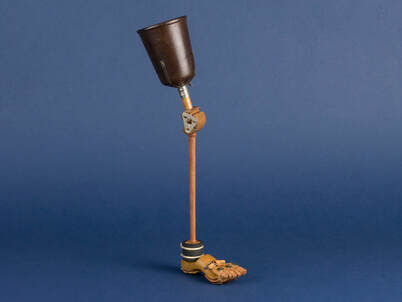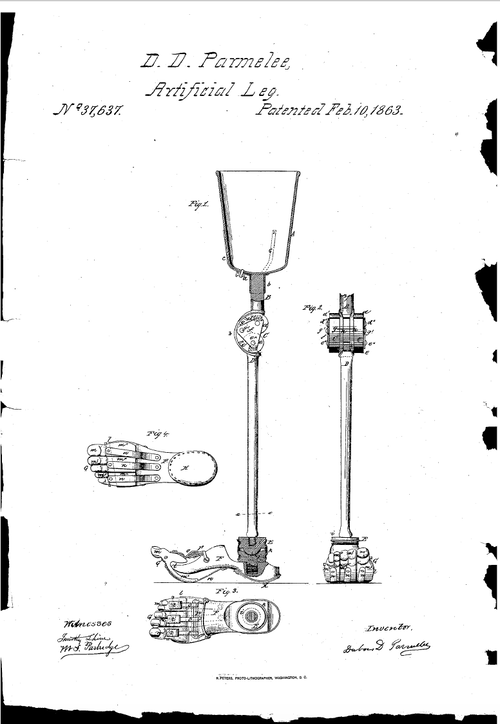 Patent Model of Parmelee Prosthetic Leg
Patent Model of Parmelee Prosthetic Leg
On February 10, 1863, U.S. Patent No.: 37,637 issued to Dubois D. Parmelee of New York City for an invention entitled "Artificial Leg". Parmelee's invention was for the first artificial limb that used a suction socket for attachment to the stump of a limb. For amputations above the knee, Parmelee's artificial leg did not require a hip band, shoulder strap or other type of suspension harness, which were conventional at the time. The invention was inspired by the ghastly injuries that were occurring during the U.S. Civil War that resulted in the widespread amputation of limbs. Indeed, it is estimated that between 50,000 to 60,000 amputations occurred during that dreadful war.
In accordance with Parmelee's invention, a mold of an amputee's stump was made using wax or plaster of paris. From this mold, a bucket was formed from metal. A faucet (valve) was connected to the metal bucket and was operable to control the passage of air into and out of the bucket. The bucket was molded such that its interior conformed so closely to the stump that the faucet had to be opened to allow the stump to be inserted into the bucket. When the stump was disposed in the bucket, the valve was closed, which effectively secured the bucket to the stump.
Depending on where an amputation was made, the interior of the bucket was engaged with (received) either an upper bone (e.g. a femur) or an intermediate bone (e.g. the tibia) of an amputee. For a leg amputation above the knee, the lower end of the bucket was connected to an artificial knee formed from two cylinders. The artificial knee, in turn, was connected by an artificial tibia to an artificial ankle and foot. The artificial ankle had a ball and socket construction, while the artificial foot included individual toes connected by leather strips and elastic rubber bands to a main foot piece.
The claims of the '637 patent were quite broad, being directed to a suction bucket for an artificial limb, either arm or leg. While the claims were broad, there is little evidence that Parmelee made any money from his patent. The adoption of suction buckets for artificial limbs did not occur until World War II, when the Germans started using the technology for its wounded soldiers. The success of the German prosthetics using suction buckets prompted its adoption in the U.S., starting in the late 1940's and early 1950's, almost 100 years after Parmelee made his invention. Parmelee's invention is just another example of an invention that was way ahead of its time. e
In accordance with Parmelee's invention, a mold of an amputee's stump was made using wax or plaster of paris. From this mold, a bucket was formed from metal. A faucet (valve) was connected to the metal bucket and was operable to control the passage of air into and out of the bucket. The bucket was molded such that its interior conformed so closely to the stump that the faucet had to be opened to allow the stump to be inserted into the bucket. When the stump was disposed in the bucket, the valve was closed, which effectively secured the bucket to the stump.
Depending on where an amputation was made, the interior of the bucket was engaged with (received) either an upper bone (e.g. a femur) or an intermediate bone (e.g. the tibia) of an amputee. For a leg amputation above the knee, the lower end of the bucket was connected to an artificial knee formed from two cylinders. The artificial knee, in turn, was connected by an artificial tibia to an artificial ankle and foot. The artificial ankle had a ball and socket construction, while the artificial foot included individual toes connected by leather strips and elastic rubber bands to a main foot piece.
The claims of the '637 patent were quite broad, being directed to a suction bucket for an artificial limb, either arm or leg. While the claims were broad, there is little evidence that Parmelee made any money from his patent. The adoption of suction buckets for artificial limbs did not occur until World War II, when the Germans started using the technology for its wounded soldiers. The success of the German prosthetics using suction buckets prompted its adoption in the U.S., starting in the late 1940's and early 1950's, almost 100 years after Parmelee made his invention. Parmelee's invention is just another example of an invention that was way ahead of its time. e


